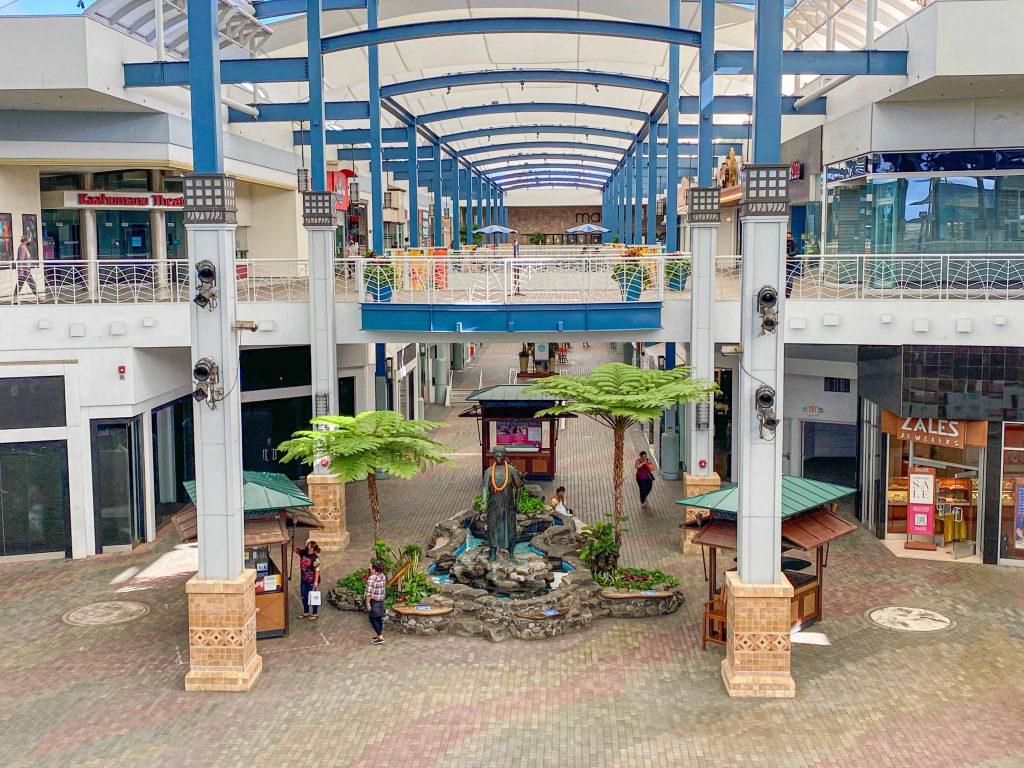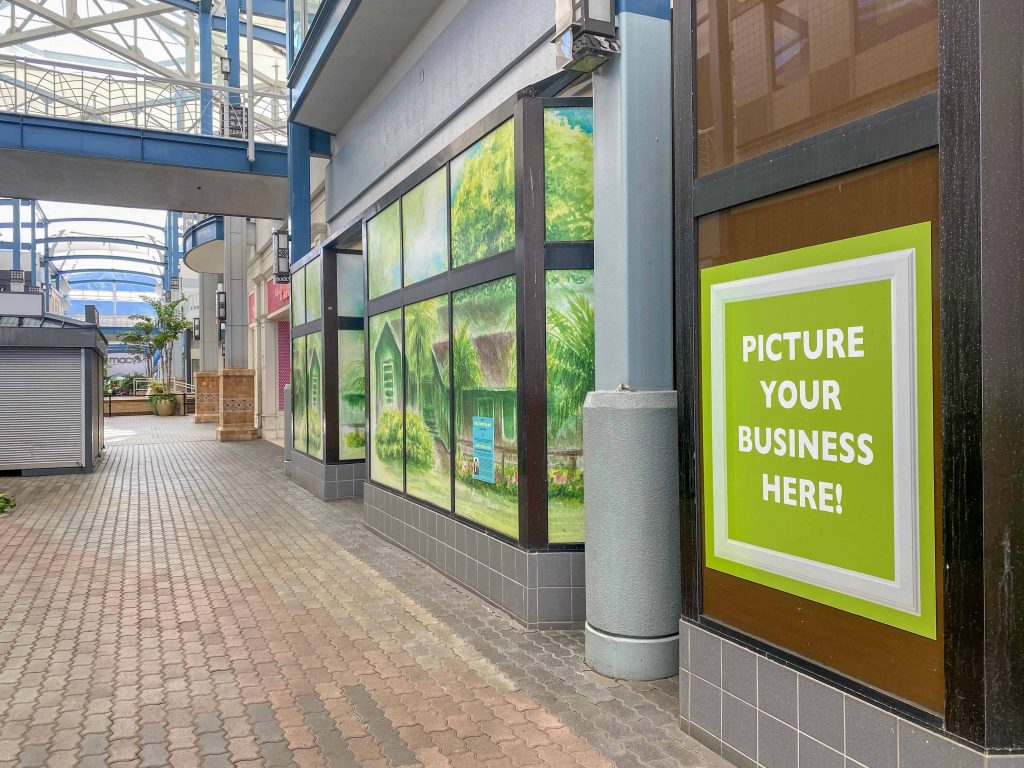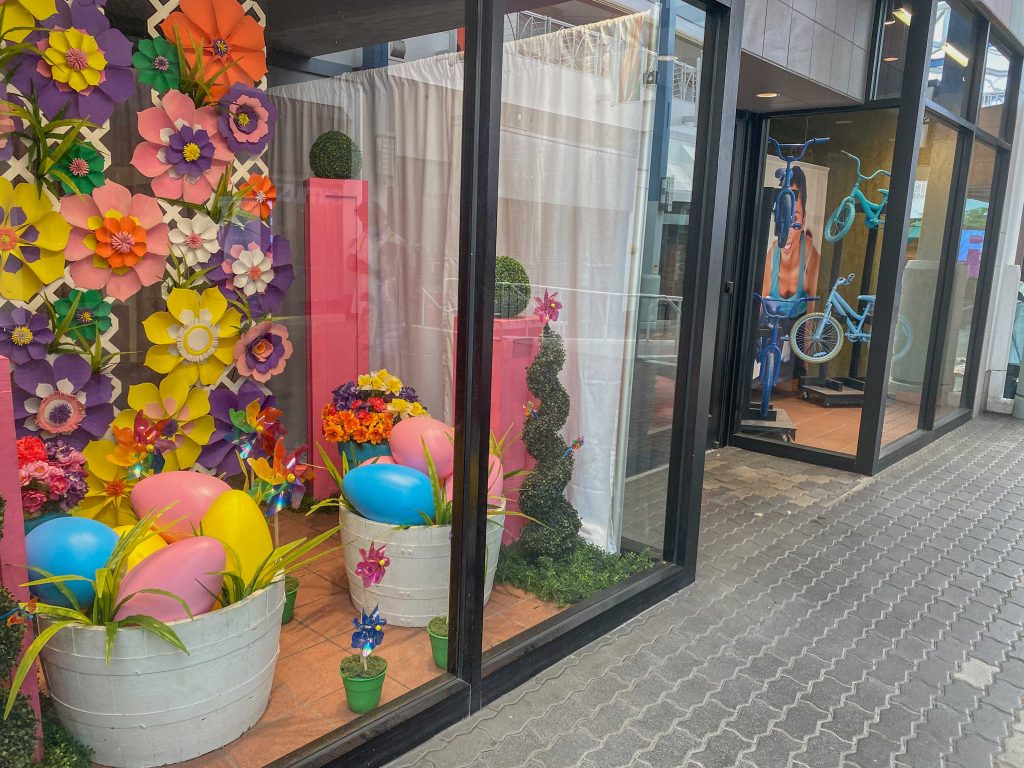Queen Kaʻahumanu Center Struggles Along as Foreclosure Case Is Litigated
Next year, the Queen Kaʻahumanu Center in Kahului should be celebrating its 50th anniversary, but no one knows if there will be any reason to commemorate the milestone.
Stroll through the place now, and it’s clear Maui’s biggest and once thriving mall is struggling for survival despite cheerfully decorated window displays of Easter eggs, balloons and children’s painted faces – that are trying to mask the growing number of vacant stores.
On Nov. 12, 2020, U.S. Bank, on behalf of holders of commercial mortgage-backed securities, filed for foreclosure on the mall. The complaint claimed owner QKC Maui Owner LLC defaulted on a $88.5 million loan that was initiated in 2014 and as of Oct. 14, 2020 owed $87.4 million.
While the global coronavirus pandemic provided the proverbial nail on the coffin, the 570,904 square-foot, open-air regional mall already was having difficulty meeting its loan obligations before the pandemic led to non-essential business shutdowns a year ago. At the end of 2019, the Queen Ka’ahumanu Center had a net operating income that was less than its total debt service, according to a report by Fitch Ratings.
The mall has been struggling for survival because many of its tenants – big and small – also have been struggling for survival. As is the case throughout the country, Amazon and other online shopping companies have been taking a big chunk out of brick-and-mortar retail sales.
There were decades when Sears was a coveted anchor store for a mall. That was the case in 1972, when Sears opened its doors as a charter tenant at the Queen Ka’ahumanu Center. But now, when a salesman in the decimated Craftsman tool section says there are no chordless drills left, with no plans to get more, it’s clear the last Sears store standing in Hawai’i is about to fall, too.
A Sears assistant manager was asked about the status of the store. She would only say, “We’re still here,” and referred a reporter without giving her name to a Sears corporate media hotline. No one answered the hotline or returned a message. Sears filed for Chapter 11 bankruptcy in the fall of 2018.
The Pacific Business Journal reported in February that the Sears space at the Queen Ka’ahumanu Center is being marketed by Wendell Brooks of JLL as an “extremely rare opportunity to acquire 86,861-square-foot, high-quality retail box in an exceptional trade area [on] Maui.”
But it’s difficult to lease space if the building that houses that space is in foreclosure.
The center’s other anchor stores, Macy’s and Macy’s Men’s Children and Home, also are part of a once iconic company that now is closing stores around the country. In February 2020, Macy’s announced its plan to close 125 locations by 2023. In January 2021, the Macy’s at the Hyatt Regency in Ka’anapali was identified as one of the closures.
While the two Macy’s at the Queen Ka’ahumanu Center were not on that closing list, the stores’ sales have been trending in the wrong direction for years.
Macy’s sales had gone from an average of $234 per square foot over a year period ending September 2015 to only $182 per square foot for a year’s period ending December 2019. Macys Men’s Children and Home sales dropped $48 per square foot over the same time period.
Sears’ sales per square foot fell even more dramatically during that period, from $221 to $48 per square foot.
The Ka’ahumanu 6 theater sales also were down significantly, from an average of $563,000 per screen in a year period ending September 2015 to $349,500 per screen in a year period ending in December 2019. A Fitch Ratings report analyzed that the decline in revenue likely was due to the Regal Megaplex at the nearby Maui Mall shopping center taking away substantial business after it upgraded its seating offerings.
The center also includes Foodland, which is in a separate building on mall property and has a longterm lease.
Struggling businesses pre-pandemic were not limited to the anchor stores. One of those pretty displays was in the windows of what was once Payless Shoe Source. In 2019, the company’s North American stores filed for bankruptcy.
The windows of what was once Forever 21 only has an advertisement that says: “Your Business Here!” with a contact for leasing information. In 2019, the company experienced a 32 percent drop in global sales and was forced into bankruptcy protection.
The pandemic turned the Queen Ka’ahumanu Center, like many places on Maui, into a ghost town. As tourism has returned and more people are getting vaccinated, some life has returned to the mall, but finding a parking spot or place to eat at the food court is easy.
Of the mall’s 143 leasable units, 46 are now vacant and two other units are leased but unoccupied for an occupancy rate based on square footage of 87.96 percent, according to the first report of court-appointed receiver Oscar Parra that was filed April 5.
A 2nd Circuit Court judge in February approved the bank’s motion to appoint Pacific Retail Capital Partners, owned by Parra, as a receiver to operate the mall. The company previously managed the mall.
The receiver’s report also showed that of the 95 units that are leased, many of the tenants are behind on their rent.
In the receiver’s court filing, there was nearly $1 million listed as “allowance for doubtful” recovery of money owed, with at least five former tenants bankrupt or in bankruptcy.
Many tenants terminated their leases early. Some are on payment plans. Some are “non-communicative.” And the filing shows the likelihood of writing off $123,183 in money owed from The Walking Company, which abandoned its location and was sold in auction in New York.
Among the tenants is the US government, which leases space at the mall for recruiting for the Army, Navy and Marines. A recruiter said: “We don’t know what’s happening.”
The Queen Ka’ahumanu Center was developed in 1972 by Honolulu’s Dillingham Land Corporation. Liberty House department store became the first operational tenant. At its grand opening celebration in 1974, there were 48 stores. Over the years it grew to more than double that number.
The center’s 40th celebration in 2012 featured an historical photo display with employees and community members sharing stories and pictures.
At the time, Marketing Manager Lisa Paulson said: “We had an overwhelming response from people wanting to share their memories for our celebration. It made us realize that Queen Ka’ahumanu Center truly is an integral part of the community.”
And now, one comment on a post of the Queen Ka’ahumanu Center Facebook Page said: “This mall is soo sad!!!” To which another poster said: “Be part of the solution not a problem.”
The plight of the mall is now playing out through the courts.

















